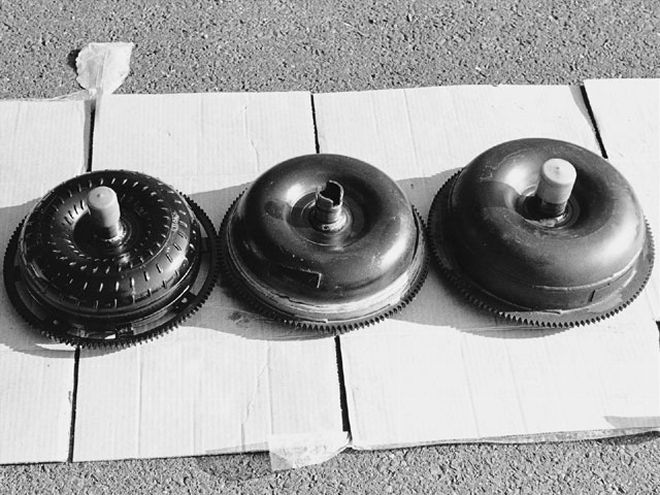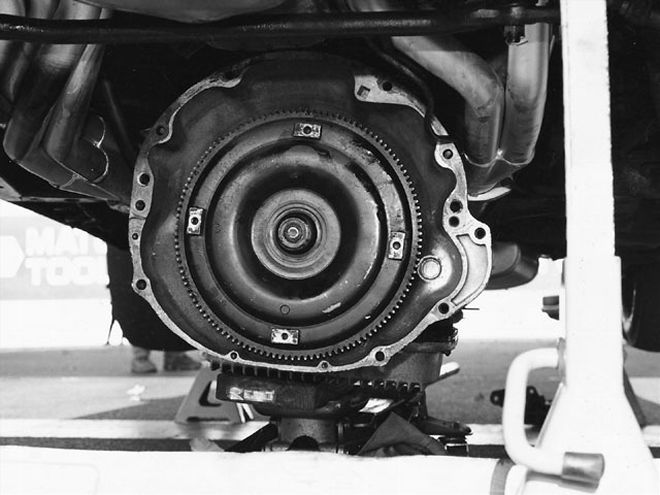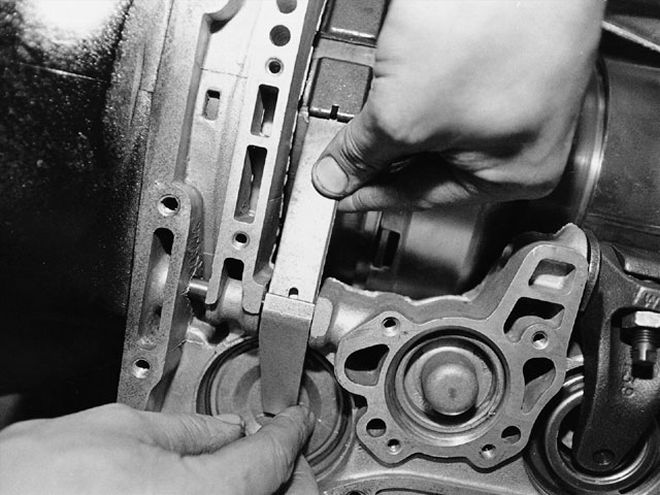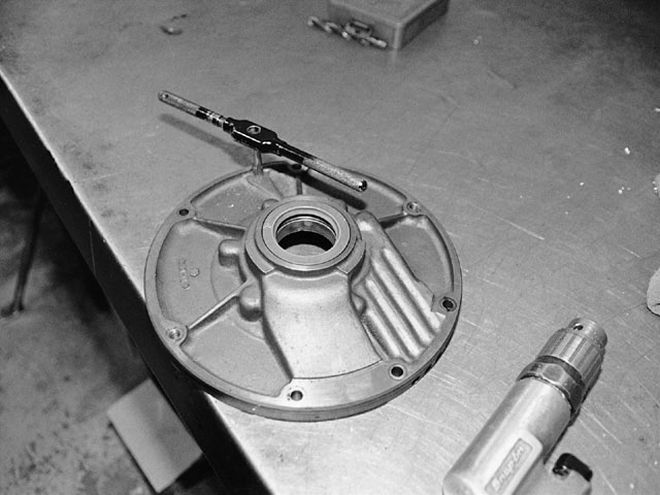
 On the left is the 9 1/2-inch Dynamic torque converter we tested, abused, and approved with our Pro-Formance 904 transmission. The middle converter is the no-name 10-inch (stock high-stall) unit we used to baseline our small-block Challenger. The big converter on the right is an 11-inch 727 unit (2,200-2,600 stall) best suited for a stock resto 383 or 440.
On the left is the 9 1/2-inch Dynamic torque converter we tested, abused, and approved with our Pro-Formance 904 transmission. The middle converter is the no-name 10-inch (stock high-stall) unit we used to baseline our small-block Challenger. The big converter on the right is an 11-inch 727 unit (2,200-2,600 stall) best suited for a stock resto 383 or 440.
Torque converters have been the subject of heated discussion in performance circles since their introduction. What stall is right for my car? What does diameter have to do with stall? Who makes the best unit? The list goes on.
We decided to answer some of these questions by testing Pro-Formance Transmissions' Dynamic 9 1/2-inch street/strip torque converters with real-world drag testing. The test vehicles included a '74 Challenger with a slightly-warmed 360/904 combo, and a '67 R/T 440/727. Our approach would be to "rollerize" the 727 internals in the R/T, then install a new 9 1/2 inch converter. Both the E-Body small-block and the B-Body big-block had 10-inch converters, but were totally different combinations (car weight, aerodynamics, and power band). We were confident these new 9 1/2-inch converters would prove their worthiness in our pair of street/strip machines.
The Challenger
When we built and strip-tested our Challenger with the 360 and Pro-Formance 904 transmission, we wanted to strip-test the stock 10-inch converter against the Dynamic 9 1/2-inch unit. We felt our 360, with its mild Summit cam (.441-inch lift and 218/228 degrees duration at .050) was a good match for the stock 10-inch converter. A conversation with Frank Lupo of Dynamic Converters/Pro-Formance Transmissions assured us that these new 9 1/2-inch units could be custom-built to match our combos while lowering our elapsed times. We would strip-test the converters at Raceway Park in Englishtown, New Jersey.
 Here, the Pro-Formance 904 is lowered onto the E-Town tarmac. This gave us just enough room to remove the 10-inch unit and replace it with the 9 1/2-inch Dynamic converter.
Here, the Pro-Formance 904 is lowered onto the E-Town tarmac. This gave us just enough room to remove the 10-inch unit and replace it with the 9 1/2-inch Dynamic converter.
While the Challenger was given time to cool down from the 90-minute drive to the track, we mounted the 26x9 Hoosier slicks. Our first baseline pass with the stock 10-inch converter netted us a 12.88 e.t. at 104.05 mph. A minute later we staged again and turned a 12.84 at 104.15 backup pass. One more hot lap for good measure posted us another 12.88 at 104.32. Our 60-foot times were 1.81, 1.82, and 1.83, respectively, for the three back-to-back runs. With a solid baseline under our belts, we pulled the Challenger under E-town's timing tower and set it on jack stands. We lowered the tranny and removed the stock 10-inch converter, replacing it with Dynamic's 9 1/2-inch unit. Even while taking pictures we still thrashed it back together inside of three hours. We filled the Pro-Formance 904 with Redline synthetic racing ATF, and the E-Body was taken on a five-minute ride, checking for possible noises and leaks. We then rechecked the fluids and were ready to fly.
Confident with the newly installed converter, we pulled our E-Body into the staging beams. Wanting to give both converters a fair shake, the launch was set at the same 2,000 rpm. The holeshot and the trip down the track felt much better, and there was not as much drop-off in rpm at the shift points. The stock converter dropped off noticeably at each shift. The 9 1/2-inch converter allowed the Challenger to stay in its power band, and give us lower elapsed times. The first pass confirmed the seat-of-the-pants feeling with a 12.64 e.t. at 104.71 mph with a 1.73 60-foot. A backup run two minutes later produced an even better 1.71 60-foot time and quarter-mile run of 12.62 seconds at 104.73 mph. We were blown away with the results-a full 1/10 in the first 60-foot, a total of 21/410 in the eighth-mile, and another 2 2/100 through the end of the quarter. As an added bonus, this converter picked up trap speed as well. Usually a higher-stalling converter will show a loss in mph-not so this time.
Unfortunately, we ran out of track time. On the ride home, the 9 1/2-inch converter cruised at the same rpm as the 10-inch unit at any given speed-all this in a mild street combo we didn't think needed a higher-stalling converter.
The Veteran
Readers of the now defunct High Performance Mopar will remember when a converter test like this was performed on the R/T. Five years ago we replaced the 11-inch converter with a 10-inch unit and found noticeable gains. This time we'll add a little twist.

Many of us have heard that a rollerized transmission will not waste as much power as a stock nonrollerized transmission. Typically, gains in the area of 1/10 of a second in the quarter-mile are common. We took the R/T's tranny to Dynamic Converters/ Pro-Formance Transmissions in Newark, Delaware, to be freshened and given the rollerizing treatment. Even after 10,000 hard street miles and more than 200 runs down the track, the TorqueFlite still worked perfectly-proof that a well-built and serviced transmission is worth the extra coin over a junkyard piece.
Transmission specialist Sean Wiley took the time to show us the machine work that goes into the planetary assembly for the placement of the rollers that eliminate the thrust washers. Sean was amazed at the condition of the 727's clutches and plates. Once the box was back together, Shawn had me spin the input and output shaft, and I couldn't believe how much easier they turned. Next, it was time to put the TorqueFlite to the dyno test. All Pro-Formance transmissions are dyno-tested for shifting, fluid pressure, and leaks.
 All Pro-Formance-built TorqueFlites have their pump vent tapped and plugged. The vent is moved outside the case to the top of the tailshaft housing. This stops vented fluid from being sprayed around in the bellhousing by the converter. It also helps reduce fluid aeration in the front pump and converter.
All Pro-Formance-built TorqueFlites have their pump vent tapped and plugged. The vent is moved outside the case to the top of the tailshaft housing. This stops vented fluid from being sprayed around in the bellhousing by the converter. It also helps reduce fluid aeration in the front pump and converter.
Back in the garage, the refreshed and rollerized transmission, with its new 9 1/2-inch converter, was returned to the R/T. The tranny was filled with regular Type F lubricant and driven around town. Next, the stock pan was replaced with a deep-finned aluminum piece that would hold four extra quarts of Red Line racing ATF. Now the 727 was ready for the local stomping grounds to check out stall, shift points, and maybe a brand X to blow away. All systems were a "go," and a test date was scheduled at E-Town.
For the R/T's baseline we'll refer back to its last outing ("Spaced Out With Carb-O-Nation", August 2002 Mopar Muscle) where it ran a best e.t. of 11.77 at 114.42 mph, and posted a 1.67 60-foot time. At E-Town, the weather conditions were fairly close to that earlier outing, averaging out the temperature, humidity and barometer. The same test weight and 26x9 Hoosier slicks were retained for a fair comparison. We must note that on this test we were putting Dynamic's own 10-inch converter against their new 9 1/2-inch unit. For our first pass we ran an 11.67 e.t. at 114.23 mph with a 1.62 60-foot time-a great start, showing us improved times across the board. We hot-lapped the car and ran an 11.68 at 114.14 with another 1.62 short time. Before the next blast, the ol' Dodge would receive a half-hour cool-down. The next pass would turn out to be the best of the day-an 11.60 e.t. at 115.06 mph. A good converter will always reduce elapsed times, and this one also increased the trap speed. The rollerized 727 and 9 1/2-inch combo rewarded us with 11.6-second runs all day, with one poor-traction run of 11.70 seconds. All the runs had 1.61-1.67 60-foot times. With the newly added torque multiplication, we should have brought our 28x9 slicks (better footprint), but we never had traction problems before.
Being happy with picking up nearly 2/10 in the quarter-mile, I called Frank Lupo the next day with our results. When Frank asked about the flash stall and trap rpm, I told him our flash was up 1,000 rpm and trap rpm was up 400. Frank thought the converter was a tad loose for our combo and apologized. He felt he should have sent us a converter with less stall. Frank also said we should have picked up 3/10, and asked if we would like to try a tighter 9 1/2-inch unit. Sounds like a good idea!
Test Results:Challenger with 2,000 rpm launch
Baseline: 10-inch converter with a 3,000 flash stall, 5,400 trap rpm.
Vehicle weight 3,640 lbs.
Weather: 65 degrees, 38-percent humidity, 30.21 barometer
Challenger w/9 1/2-inch Dynamic converter: 4,200 flash stall, 5,700 trap rpm.
Vehicle weight 3,630 lbs minus 10 lbs (converter weight).
Weather: 66 degrees, 40-percent humidity, 30.18 barometer
Test Results:
'67 R/T with 3.73 gears and 2,000 rpm launch
Baseline: 10-inch Dynamic converter with a 3,800 flash stall, 6,000 trap rpm, vehicle weight 4,005 lbs.
Weather: 68 degrees, 45-percent humidity, 30.29 barometer
Test: 9 1/2-inch Dynamic converter in a rollerized 727. Converter with 4,800 flash stall, 6,300 trap rpm, vehicle weight 4,010 lbs., plus 5 lbs. for roller weight
Weather: 59 degrees, 48-percent humidity, 30.08 barometer
Conclusion
Converter technology has significantly improved since the musclecar era began. Years ago, higher stall meant more slippage at cruising speeds and less top-end speed at the strip. Today, using a high-quality converter gives you good cruising rpm and the trap speed of a stock converter. Remember, when contemplating the purchase of a new converter, you will get what you pay for. A reputable manufacturer will need a complete spec list on your combo to build the right converter for your car.